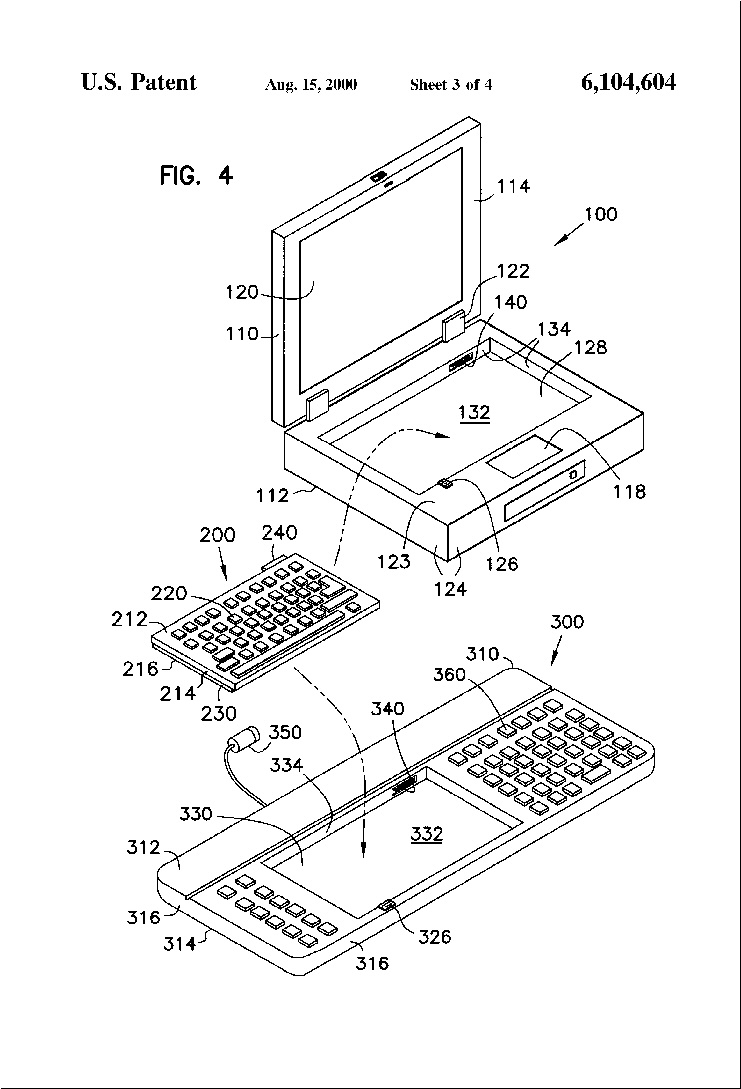

| United States Patent | 6,104,604 |
| Anderson , et al. | August 15, 2000 |
A modular keyboard is provided which can be repeatedly and conveniently transferred between a portable computer or a desktop computer without damage to the modular keyboard. Both the portable computer and the keyboard base for the desktop computer have a cavity therein for receiving the modular keyboard. The keyboard base has a numerical keypad and arrow keys adjacent the cavity. The modular keyboard is small enough so that the portable computer can be closed and carried in the conventional manner without interference from the modular keyboard. A removal mechanism is provided on each the portable computer and the keyboard base to facilitate removal of the modular keyboard.
| Inventors: | Anderson; Glen J. (Sioux City, IA); Radle; Karla A. (Sioux City, IA) |
| Assignee: | Gateway 2000, Inc. (North South City, SD) |
| Appl. No.: | 003575 |
| Filed: | January 6, 1998 |
| Current U.S. Class: | 361/680; 400/479 |
| Intern'l Class: | H05K 005/02; G06F 001/16 |
| Field of Search: | 361/680,681,683 400/479,489,492,493 364/708.1 |
| 4488146 | Dec., 1984 | Burchart. | |
| 4564751 | Jan., 1986 | Alley et al. | 235/146. |
| 4739451 | Apr., 1988 | Kuba | 361/394. |
| 5144302 | Sep., 1992 | Carter et al. | 314/20. |
| 5187644 | Feb., 1993 | Crisan | 361/393. |
| 5264992 | Nov., 1993 | Hogdahl et al. | 367/681. |
| 5510953 | Apr., 1996 | Merkel | 361/680. |
| 5519569 | May., 1996 | Sellers | 361/680. |
| 5526493 | Jun., 1996 | Shu | 395/281. |
| 5561589 | Oct., 1996 | Mesfin et al. | 361/686. |
| 5568359 | Oct., 1996 | Cavello et al. | 361/686. |
| 5576929 | Nov., 1996 | Uchiyama et al. | 361/680. |
| 5615081 | Mar., 1997 | Ma | 361/680. |
| 5661633 | Aug., 1997 | Patret | 361/683. |
| 5865546 | Feb., 1999 | Ganthier et al. | 400/489. |
"Japanese Patent Abstract", vol. 013, No. 172 (P-862) & JP 01 007212 A (Toshiba Corp). Title: Personal Work Station, Publication number 01007212; Application date Jun. 30, 1987, (Jan. 11, 1989). "Japanese Patent Abstract", vol. 097, No. 006 & JP 09 054640 A, Fuji Xerox Co. Ltd. Title: Keybroard Device and Key Unit Therefor, Publication number 09054640; Application number Aug. 18, 95, (Feb. 25, 1997). "Japanese Patent Abstract vol. 017, No. 277", (P-1546) & JP 05 011885 A (Hitachi Ltd.) Title: Information Processor, Publication number 05011885; application date Mar. 7, 91, (Jan. 22, 1993). "Patent Abstracts of Japan", vol. 096 No. 008 & JP 08 087349 A (Tec Corp) Title: Portable Computer Device, Publication number 08087349; Application date Sep. 16, 1994, (Apr. 2, 1996). |